Hey there!
So you’ve got yourself a French Bulldog puppy, huh? Well, let me tell you, training these little cuties can be a real adventure. But don’t worry, I’ve got some tips and tricks up my sleeve that will make the process a whole lot easier.
From crate training to potty training and teaching basic commands, I’ve got you covered. So sit back, relax, and get ready to unlock the secrets of training your French Bulldog like a pro.
Let’s dive in!
Key Takeaways
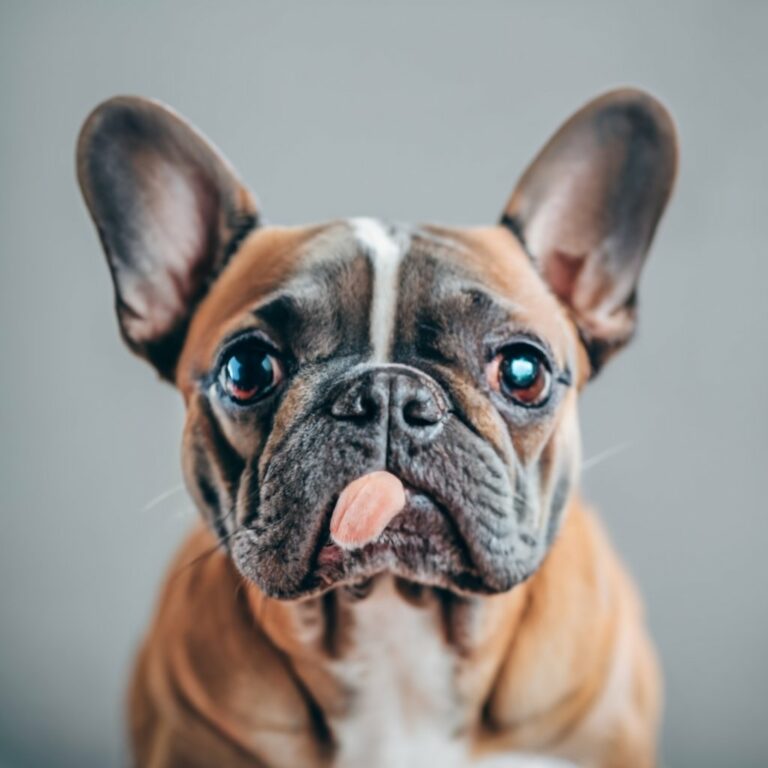
- Crate training is important for potty training and preventing destructive behavior.
- Consistency and routines are crucial for successful potty training.
- Teaching basic commands strengthens the bond and improves obedience.
- Positive reinforcement and clicker training techniques are effective in command training.
Crate Training Basics
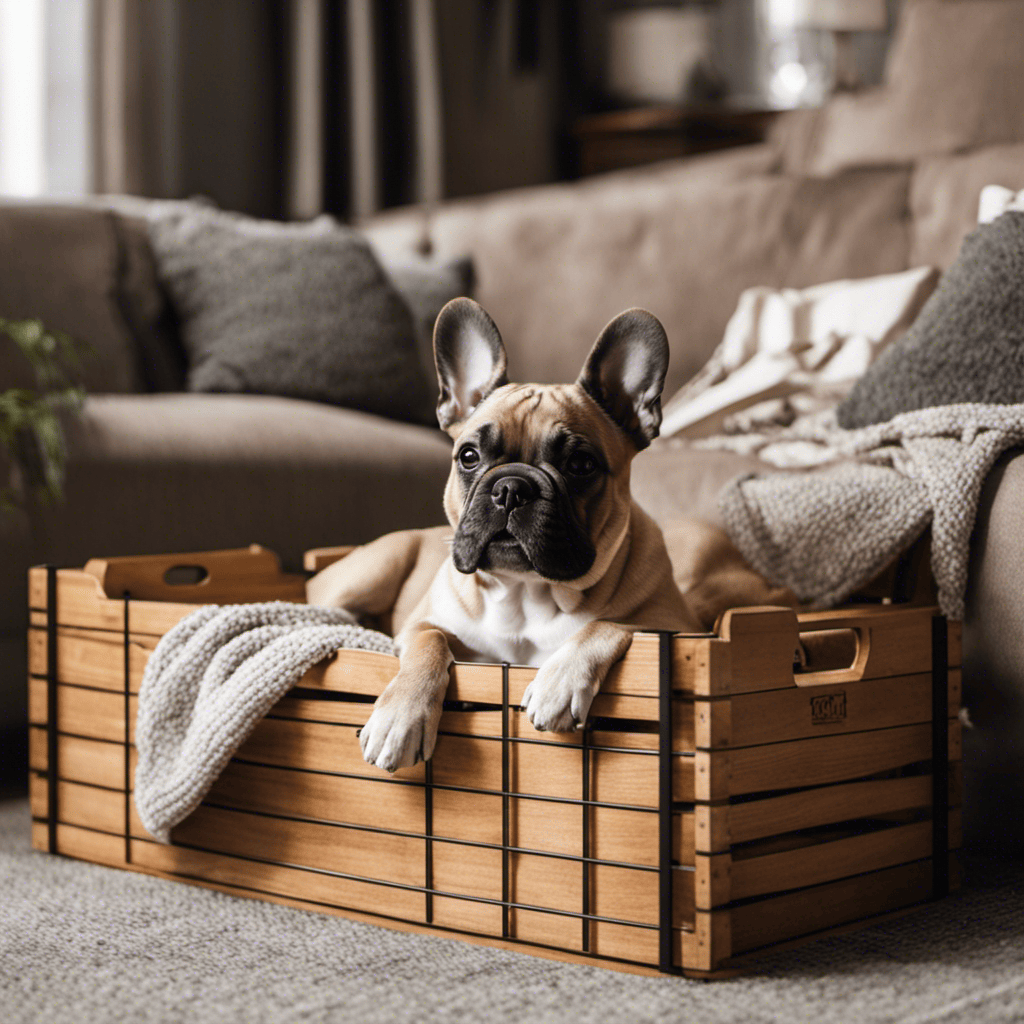
I can’t stress enough how important it’s to understand the crate training basics if you want your French Bulldog puppy to feel safe and secure. Crate training isn’t only a great way to provide your pup with a space of their own, but it also helps with potty training and preventing destructive behavior.
When it comes to crate training stubborn French Bulldogs, consistency is key. Make the crate a positive and inviting space by placing treats, toys, and a comfy blanket inside. Start by leaving the door open, allowing your pup to explore and get comfortable with the crate at their own pace. Gradually increase the time your puppy spends in the crate, rewarding them with treats and praise.
If your French Bulldog experiences separation anxiety, crate training can help them feel more secure. Start by leaving your pup in the crate for short periods while you’re home, gradually increasing the time. Be sure to provide plenty of exercise and mental stimulation before crating them, as this can help reduce anxiety.
Now that you have mastered the crate training basics, it’s time to move on to potty training made simple.
Potty Training Made Simple

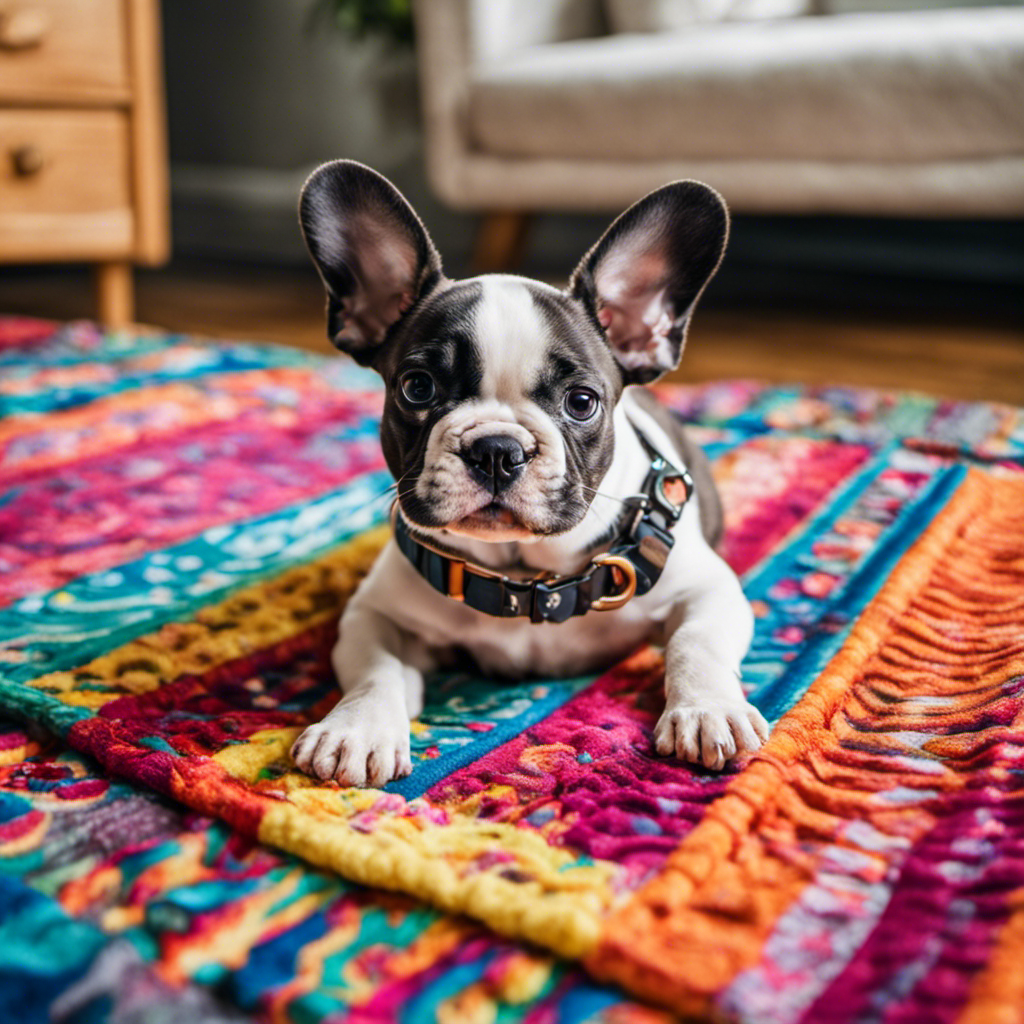
Potty training my French Bulldog puppy has become much simpler since implementing consistent routines and positive reinforcement. When it comes to housebreaking methods for French Bulldogs, consistency is key. Establishing a routine and sticking to it helps your puppy understand when and where they should go potty.
Start by taking your puppy outside to their designated potty area first thing in the morning, after meals, and before bed. Be patient and give them plenty of time to do their business. When they eliminate in the right spot, praise and reward them with treats or verbal praise. This positive reinforcement helps reinforce the desired behavior.
To successfully train a French Bulldog to use a designated potty area, it’s important to be diligent and observant. Watch for signs that your puppy needs to go, such as sniffing or circling. Take them outside immediately to avoid accidents indoors. Consistency and positive reinforcement are key throughout the entire training process.
Teaching Basic Commands

Teaching basic commands is an essential part of training any dog, including French Bulldogs. By using effective command training techniques, such as positive reinforcement, you can establish a strong bond with your puppy and improve their obedience.
Consistency in training is key to ensuring that your French Bulldog understands and follows the commands consistently, leading to a well-behaved and happy companion.
Effective Command Training
While training my French Bulldog puppy, I found that effective command training requires consistency and positive reinforcement. Here are four tips that have helped me in this process:
-
Clicker training techniques: Clicker training is a popular method that uses a small handheld device to make a distinct clicking sound, signaling to your puppy that they’ve performed the desired behavior correctly. This positive reinforcement helps them understand what you want them to do.
-
Using hand signals for command training: Dogs are highly visual creatures, and incorporating hand signals alongside verbal cues can enhance their understanding of commands. For example, raising your hand palm-up can be associated with the ‘sit’ command.
-
Consistency is key: Dogs thrive on routine and repetition. By consistently using the same words and gestures for commands, you establish clear expectations for your puppy. This helps them learn faster and prevents confusion.
-
Positive reinforcement: Instead of punishing your puppy for making mistakes, focus on rewarding and praising them for good behavior. This creates a positive training environment and motivates your puppy to repeat the desired actions.
Positive Reinforcement Techniques
I have found that using consistent and frequent positive reinforcement techniques greatly improves my French Bulldog puppy’s ability to learn basic commands. Teaching tricks to my puppy has been an enjoyable experience and it has strengthened our bond.
One effective technique I’ve used is clicker training. By associating the sound of the clicker with a reward, such as a treat, my puppy quickly learned to associate the click with a job well done. This has helped in teaching more complex tricks and commands. Clicker training techniques have been proven to be highly effective in dog training, as they provide clear communication and reinforce positive behavior.
Consistency in training is key to success. By maintaining a regular training schedule and using the same commands and reward system, my puppy has learned to respond reliably and consistently.
Consistency in Training
Practicing basic commands consistently with my French Bulldog puppy has noticeably improved her obedience skills. Here are four key reasons why consistency is crucial in puppy training:
-
Importance of routine in puppy training: Establishing a consistent routine helps your puppy understand what’s expected of them and creates a sense of security. This routine should include regular feeding times, potty breaks, and training sessions.
-
Balancing discipline and reward in consistent training: Consistency allows you to strike a balance between discipline and reward. By consistently enforcing rules and boundaries, your puppy learns what behaviors are acceptable. At the same time, rewarding desired behaviors with treats, praise, or playtime reinforces positive behavior.
-
Building trust and communication: Consistency in training builds trust between you and your puppy. When they understand what you expect from them, they feel secure and confident in their actions. Additionally, consistency helps to establish clear communication between you and your furry friend.
-
Creating lifelong habits: Consistency in training creates lifelong habits for your puppy. By practicing commands consistently, you’re setting them up for success in the long run. With time and repetition, these commands become second nature to your puppy, making their obedience skills reliable and consistent.
Socialization Tips for French Bulldogs


I’ve found that introducing my French Bulldog to new people and environments from a young age has been crucial for their socialization. French Bulldogs are known for their friendly and sociable nature, but it’s important to provide them with opportunities to interact with other pets and overcome any fear they may have of new environments. Here are some tips to help you in these areas:
| Introducing your French Bulldog to other pets | Helping your French Bulldog overcome fear of new environments |
|---|---|
| Gradual introductions are key. Start with short, supervised interactions with calm and friendly pets. | Slowly expose your Frenchie to different environments, starting with quieter places and gradually increasing the level of activity. |
| Use positive reinforcement to reward good behavior during interactions. | Bring treats and toys to help distract and comfort your Frenchie in new environments. |
| Provide a safe space for your Frenchie to retreat to if they feel overwhelmed. | Stay calm and reassuring to help your Frenchie feel more at ease. |
| Seek professional help if your Frenchie continues to struggle with socialization. | Be patient and understanding, as it may take time for your Frenchie to adjust to new situations. |
Managing Separation Anxiety
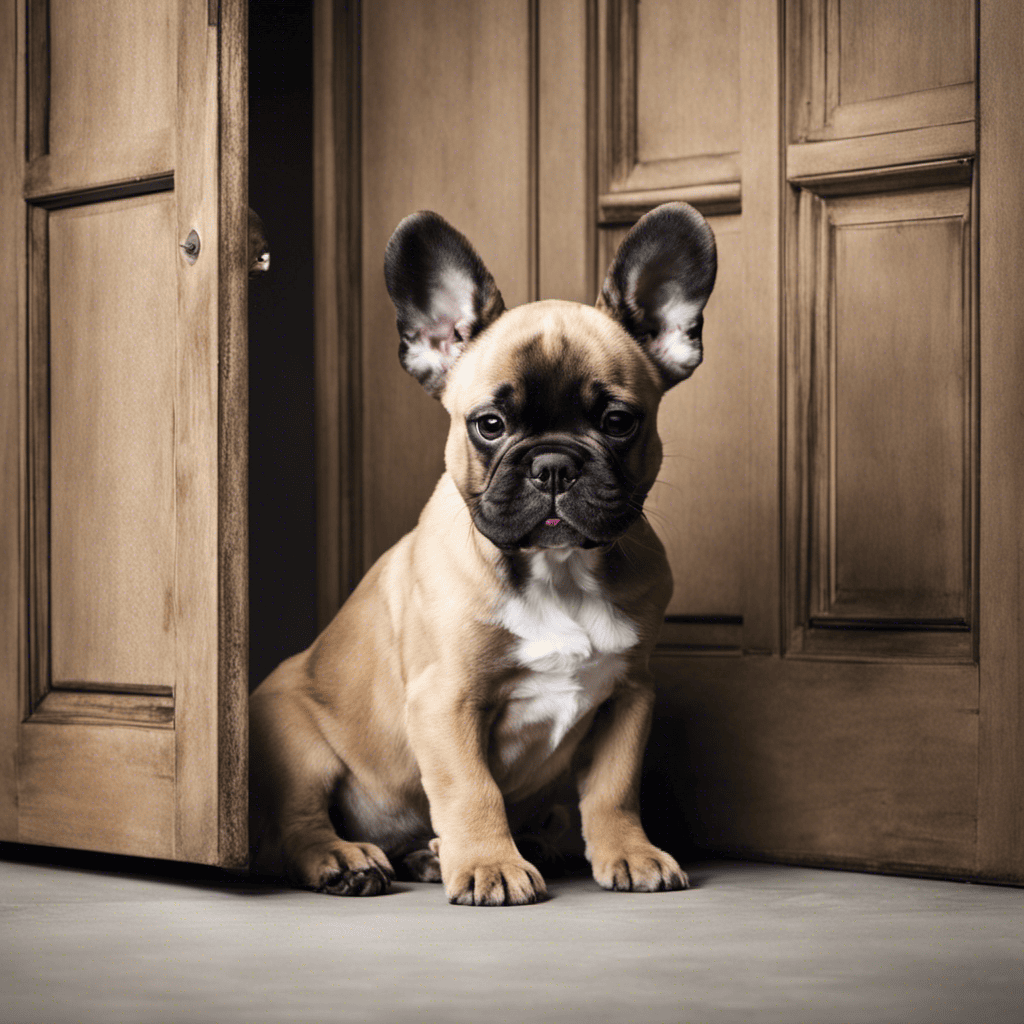
Managing separation anxiety in dogs is crucial for their well-being. It’s important to prevent destructive behavior by gradually increasing the time they spend alone and providing them with engaging toys or puzzles.
Building trust and confidence through positive reinforcement training can help alleviate separation anxiety and create a more independent and confident dog.
Preventing Destructive Behavior
The key to preventing destructive behavior in my French Bulldog puppy is establishing a consistent routine. By following these steps, you can effectively redirect your puppy’s chewing behavior and set boundaries for their chewing:
-
Provide appropriate chew toys: Make sure to have a variety of chew toys available for your puppy to chew on. This will help redirect their chewing behavior away from your furniture or belongings.
-
Supervise and redirect: Keep a close eye on your puppy and intervene when you catch them chewing on something they shouldn’t. Redirect their attention to an appropriate chew toy and praise them when they engage with it.
-
Use deterrents: If your puppy continues to chew on forbidden items, you can use taste deterrent sprays or bitter apple to make them less appealing.
-
Create a puppy-proof environment: Remove any items that your puppy may be tempted to chew on and make sure they have a safe, designated space where they can play and relax.
Building Trust and Confidence
To build trust and confidence, I provide my French Bulldog puppy with consistent daily exercise and playtime, which helps manage their separation anxiety.
Bonding exercises for new French Bulldog owners are crucial in establishing a strong foundation of trust and loyalty. Spending quality time together, such as going for walks, playing fetch, or even just cuddling on the couch, helps to create a deep connection between you and your puppy.
Additionally, it’s important to address any fear or shyness that your French Bulldog may exhibit. Gradual exposure to new environments, people, and other animals can help them overcome their anxieties and build confidence. Patience, positive reinforcement, and consistency are key when working through these challenges.
By investing time and effort into building trust and confidence, you can create a happy and well-adjusted French Bulldog.
Now, let’s move on to problem solving: addressing common behavior issues.
Problem Solving: Addressing Common Behavior Issues
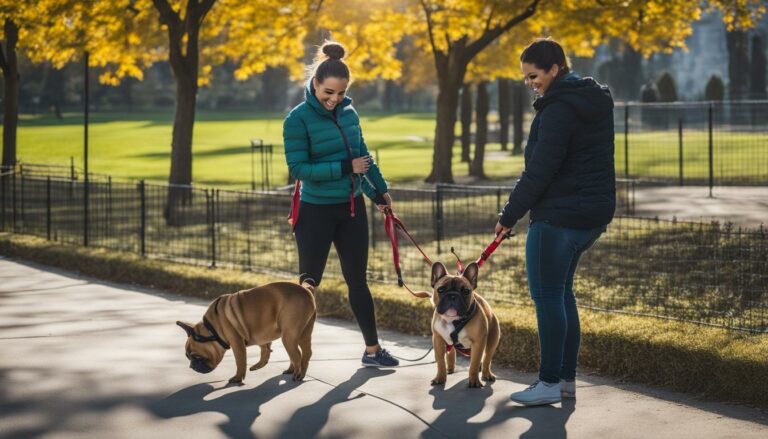
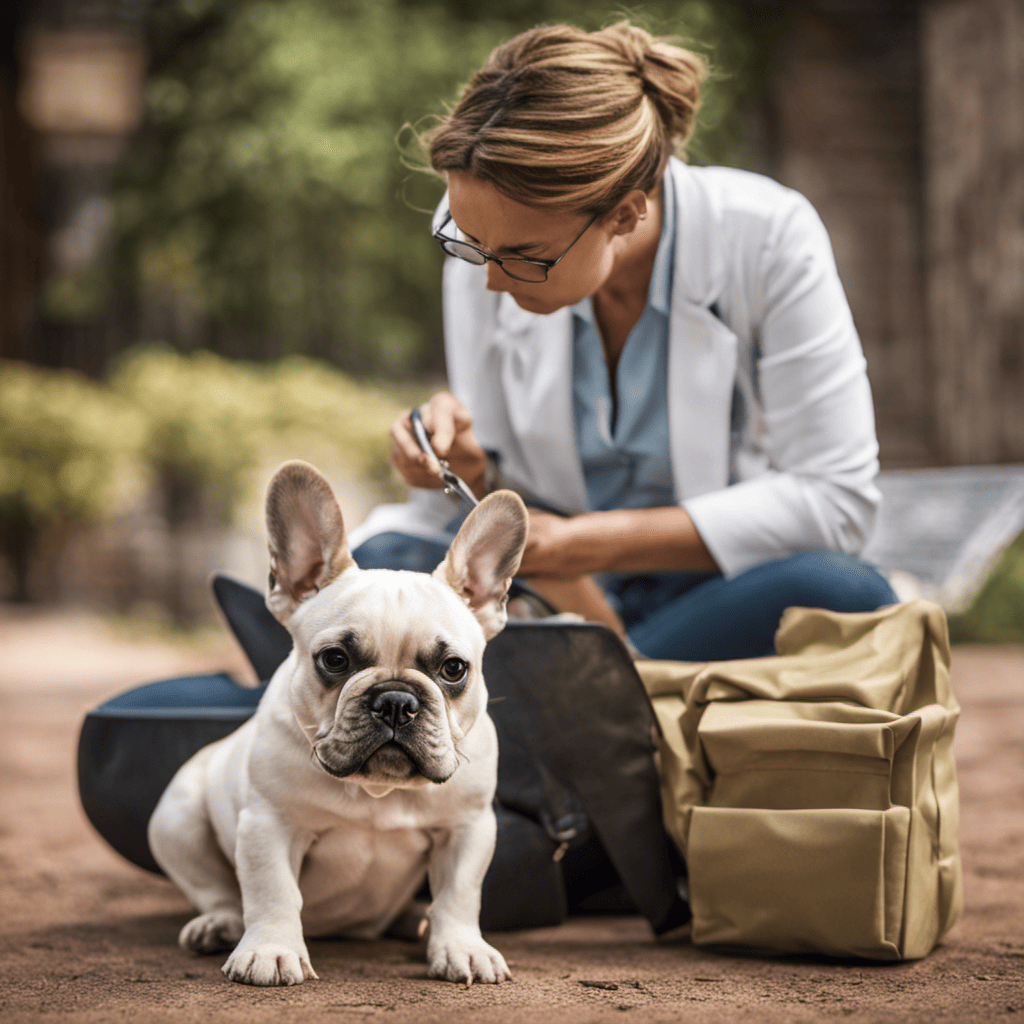
I’ve encountered three common behavior issues while training my French Bulldog puppy. It has been an interesting journey filled with challenges and learning opportunities. Here are the top issues I faced and the solutions I found:
-
Crate Training Difficulties: Many puppies struggle with crate training, and my French Bulldog was no exception. To overcome this, I made the crate a positive and inviting space by placing treats and toys inside. I also gradually increased the time spent in the crate, making sure to reward good behavior.
-
Leash Pulling: French Bulldogs are known for their stubbornness, and leash pulling was a common issue. To address this, I used positive reinforcement techniques. Whenever my puppy walked calmly on the leash, I rewarded him with treats and praise. I also utilized a no-pull harness to provide better control during walks.
-
Jumping on People: French Bulldogs are social and may have a tendency to jump on people when excited. To discourage this behavior, I taught my puppy the ‘off’ command. Whenever he jumped, I firmly said ‘off’ and redirected his attention to a toy or treat on the ground.
Training a French Bulldog puppy requires patience, consistency, and positive reinforcement techniques. By addressing these common behavior issues, I was able to create a well-behaved and happy companion.
Frequently Asked Questions
How Long Does It Usually Take to Crate Train a French Bulldog Puppy?
Crate training duration varies depending on the puppy’s age and temperament. Consistency and positive reinforcement are effective methods for crate training. It typically takes a few weeks to a few months for a French Bulldog puppy to become fully crate trained.
Can I Use Pee Pads for Potty Training My French Bulldog Puppy?
Yes, you can use pee pads for potty training your French Bulldog puppy. They offer convenience and can be helpful, but it’s important to gradually transition them to outdoor potty training for long-term success.
Are French Bulldogs More Difficult to Train Compared to Other Dog Breeds?
Yes, French Bulldogs can be more stubborn than other breeds, but with proper training and early socialization, they can become well-behaved companions. It’s important to establish clear rules and boundaries from the start.
What Methods Can I Use to Socialize My French Bulldog Puppy With Other Dogs?
To socialize my French Bulldog puppy with other dogs, I can start by introducing them at the dog park. I’ll use positive reinforcement training techniques to encourage good behavior and create a positive association with other dogs.
How Can I Prevent My French Bulldog Puppy From Barking Excessively When Left Alone?
When left alone, I prevent my French Bulldog puppy from excessive barking by teaching alternative behaviors and preventing separation anxiety. It’s crucial to create a calm environment and gradually increase alone time to build their confidence.
Conclusion
In conclusion, training a French Bulldog puppy can be a rewarding experience for both the owner and the dog. By following the tips and tricks mentioned in this article, such as crate training, potty training, teaching basic commands, socialization, and managing separation anxiety, you can ensure a well-behaved and happy furry companion.
One might argue that training a puppy can be time-consuming and challenging, but with patience and consistency, the results will be worth it. Remember, a well-trained French Bulldog is a joy to have in any household.
Hi, I’m Alex! At FrenchyFab.com, I share my expertise and love for French Bulldogs. Dive in for top-notch grooming, nutrition, and health care tips to keep your Frenchie thriving.



